It isn’t news to anyone that Aotearoa is currently marking a significant anniversary, as we pass the 250 years since James Cook circumnavigated this country’s islands in the H.M.B. Endeavour. Some see it as a cause for celebration, others commemoration, and still others consider it a time to better highlight the impact colonialism has had on Aotearoa and its tangata whenua, from that first arrival through to today.
It’s also not news to anyone in the literary community that there have been myriad books for all ages on the topic of Cook’s voyages popping in in the last 12 months, from various Pākehā, Māori and Polynesian creators. This review includes two of the most recent additions to the growing body of options available.
Whatever your personal perception of Cook, his mission, and his impact on Aotearoa, there is no arguing with the fact that two and a half centuries ago marked a hugely significant moment in this country’s history. So in addition to two titles connected to Cook’s voyaging to Aotearoa, it’s appropriate to also cover a book that delves into four other major turning points in our history as a nation. Without further ado, here’s First Map, The Adventures of Tupaia and Hindsight.
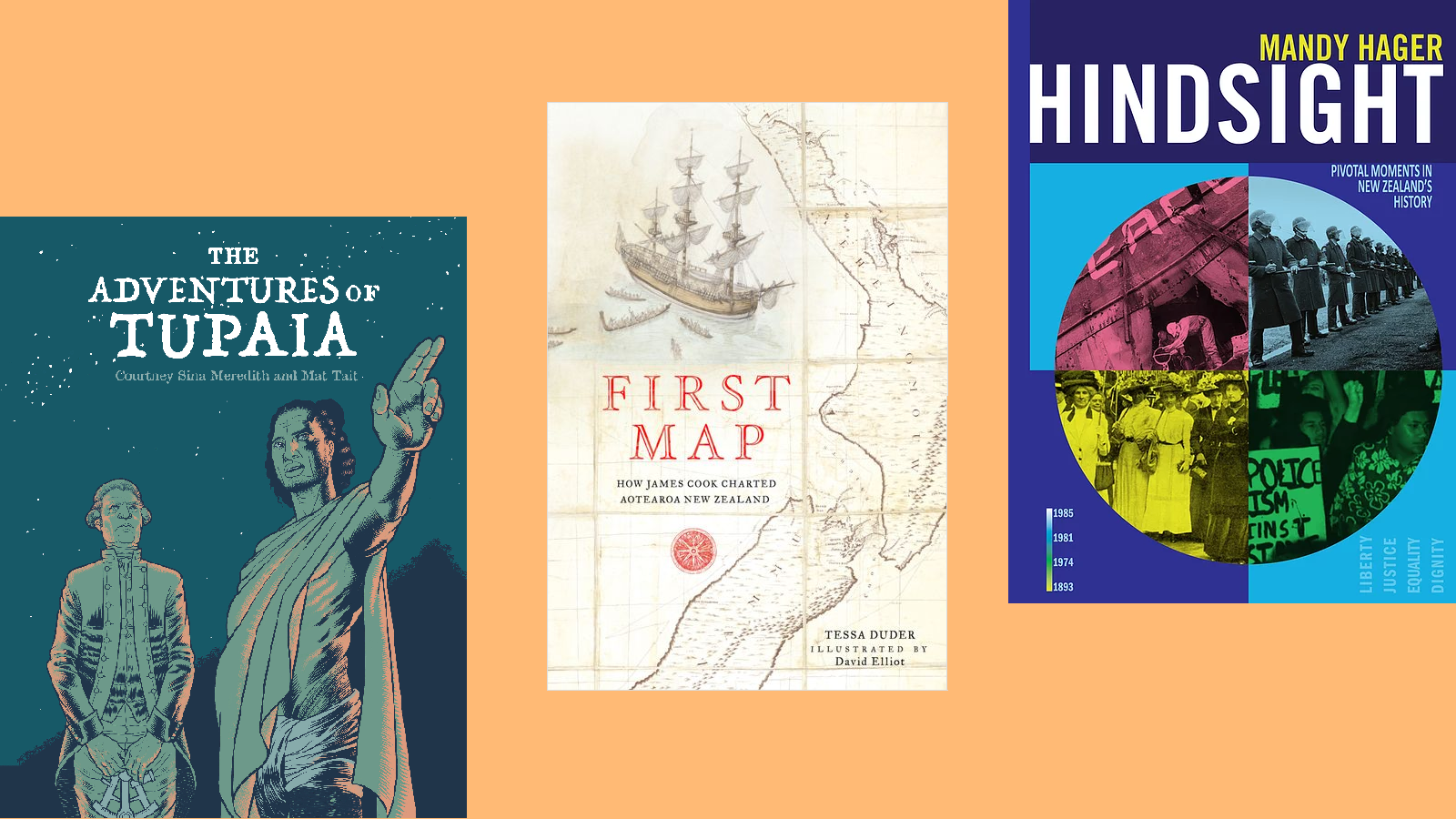
First Map by Tessa Duder, illustrated by David Elliot (HarperCollins NZ)
Before even looking into the pages of Tessa Duder’s First Map: How James Cook Charted Aotearoa New Zealand, there are two things that are clear.
Firstly: it is a beautifully produced book. It is an elegant hardback, tall and slender, and David Elliot’s illustrations meld perfectly with the facsimile map that stretches across the front cover. The pages are glossy and weighty. The dust jacket folds out into a replica of the map, designed to be flattened out and hung on the wall – if that’s your cup of tea. It’s really a very special book.
Secondly: it’s not a children’s book, but instead, I’d describe it as a family book. It’s not pitched at younger readers, however, both author and illustrator are best known for their work for young people. So call it approachable for young readers, but not targeted at them. But given the content of the book, it’s certainly going to be one featuring in school libraries all over the country, so it’s appropriate to keep it included in reviews here on The Sapling.
But that’s all prior to the actual reading. Tessa’s style of writing is eminently readable, and it could just have easily been left to a slim creative non-fiction volume, sans illustrations. I have always loved Tessa’s work, from my first read of Alex and Night Race to Kawau in Year 6 through to many, many re-reads of the Tiggie Tompson trilogy as a teen (and, admittedly, as a twenty-something too). She weaves what could be dry and fact focused into a narrative that makes for a compelling read, and her own experience as a sailor is clear in her easy weaving in of shipshape terminology.
She weaves what could be dry and fact focused into a narrative that makes for a compelling read…
And while I said the book could have been left with words alone – and, I supposed, the map itself – David Elliot’s illustrations really do kick the book up several notches. There are purely original pieces, conjured up to work alongside Tessa’s words, and others where he takes known artworks and sketches and recreates them in his own style. The combination of realism and a slightly smoky dreamlike quality do work wonderfully to enhance the storytelling.
There are a few elements that I would query, if I were proofreading the book myself – slight inconsistencies here and there. It looks as though they’ve stuck fairly firmly to the New Zealand Geographic Board’s directives on macrons, which does mean one or two names stuck out to me. Kaikōura’s increasingly got a macron on it in common usage (it even does on New Zealand Tourism’s newzealand.com website!) but it hasn’t in the book. Similarly, in the wrap up chapters on Cook’s later voyages and eventual untimely end, Hawaiʻi has been written both as ‘Hawai’i’ and ‘Hawaii’ – two versions, and neither with the official preferred ʻokina.
For the most part, Cook’s linguistic anachronisms and perhaps personal idiosyncracies have been left in the quotes from his journals – erratic capitalisation, spellings that read as erroneous to us today – but the word Māori has been macronised. It feels to me that it should go one way or the other – either full commitment to Cook’s spelling, ‘sellery’ and all, or modernise it across the board.
That being said, as something of an armchair language nerd, I do find the English attempts to write down Māori names quite fascinating – for example, you only need to look at the map itself to see the South Island labelled as ‘Tovypoenammu’, a clear precursor to one of the Māori names it is known by today: Te Wai Pounamu.
…you only need to look at the map itself to see the South Island labelled as ‘Tovypoenammu’, a clear precursor to one of the Māori names it is known by today: Te Wai Pounamu.
This is not a book to be read in isolation, but then, none of the books marking this occasion are. Cook’s foibles are glossed over, with incidents involving slaughter labelled ‘unfortunate’ – muskets versus taiaha and patu makes for hardly a fair fight, and it seems to me fair to therefore label these kinds of events using a word like ‘slaughter’, however unpalatable they may sound and however noble the goals of Cook may have possibly been.
Read this book – relish in its illustrations, delight in the easy cadence of its storytelling, but do so alongside other stories of this pivotal moment in Aotearoa’s colonial history.
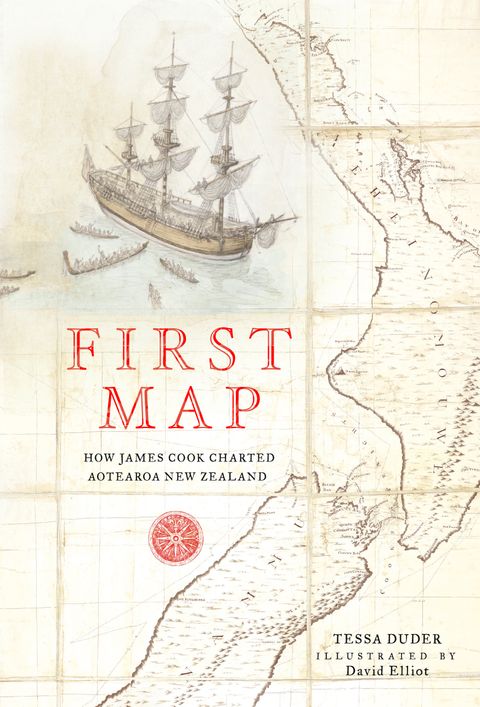
FIRST MAP: How James Cook Charted Aotearoa New Zealand
By Tessa Duder
Illustrated by David Elliot
HarperCollins NZ
RRP $49.99
The Adventures of Tupaia by Courtney Sina Meredith, illustrated by Mat Tait (Allen & Unwin NZ)
This book is exquisite. There have been a few additions in the past couple of years by New Zealand creators into the big and beautiful illustrated children’s non-fiction realm… but not many. This is a book worth of the descriptor illustrated non-fiction – as opposed to non-fiction that happens to have a few illustrations or photos.
The Adventures of Tupaia is Courtney Sina Meredith’s second book working with Allen & Unwin and Auckland Museum, but her first collaboration with Mat Tait. Courtney’s first kids book, Secret World of Butterflies (illustrated by The Sapling’s own resident comic genius, Giselle Clarkson!) was designed for a pre-schooler demographic, while The Adventures of Tupaia is pitched at an older audience, 8-to-12-ish. But its appeal is much broader than that core audience, with rich language that dances between prose and poetry, and incredible illustrations that do a lot with a muted colour palette on each spread.
[The book’s] appeal is much broader than that core audience, with rich language that dances between prose and poetry, and incredible illustrations…
We see Tupaia’s early days as a child on Raʻiātea, and touch on his journey to become a priest and navigator. Cook’s arrival on ‘a pahī the size of an island’ is something that leaves Tupaia awestruck – and his eventual joining the Endeavour crew is his chance for adventure and a return to places he visited as a child.
Seeing the Endeavour voyage from Tupaia’s perspective is deeply interesting. There are the ways in which he struggled to articulate his Polynesian (and often antithetical to British) understandings of navigation and the natural world. There’s his ability to translate for the Endeavour’s crew, an incredible feat by their reckoning, given that Aotearoa is some 4000 kilometres away from Raʻiātea and Tahiti – but simply an indication of the navigational talents of the broader Polynesian family, from fenua to whenua. As a Polynesian woman – specifically with Samoan, Mangaian and Irish roots – Courtney tells Tupaia’s story thoughtfully and with the weight of inter-connected tūpuna behind it.
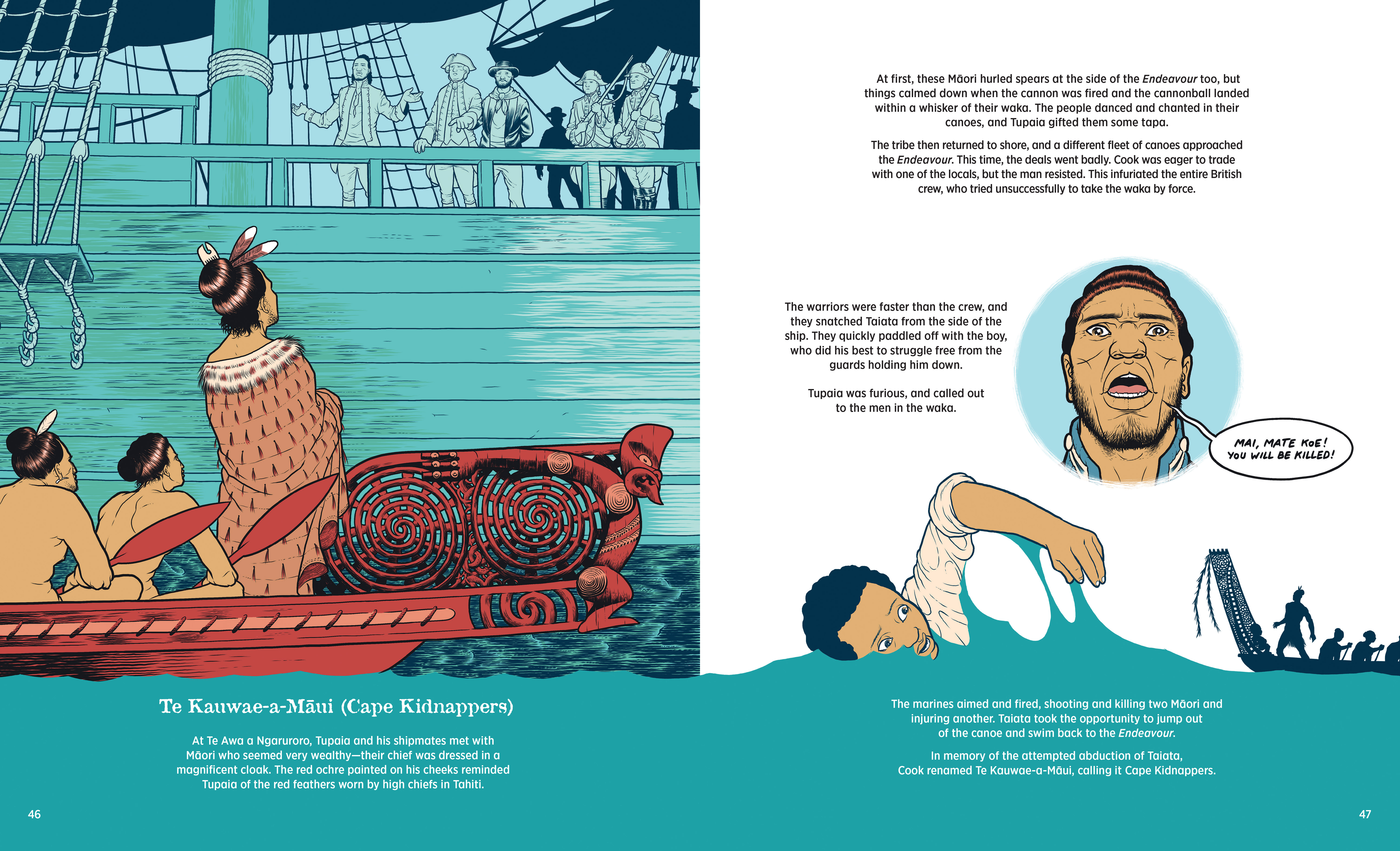
The writing is beautiful and lyrical even in the prose sections, and Mat’s illustration melds perfectly with Courtney’s words – at times, gazing at illustrations with writing carefully integrated into it, I had to remind myself that this was the work of two people, not just one. I really hope that the two of them do further work together – as a children’s bookseller with a lot of time spent spruiking New Zealand titles, there’s definitely an appetite for more beautiful true New Zealand tales to be told in book form.
Further to my brief rant about ʻokina in my previous review, it’s only right to commend this book’s careful use of the glottal stop indicators. The Tahitian ʻeta isn’t actually able to be rendered in regular typed script (it’s basically like the ʻokina but rotated a quarter turn) – and while, as I understand it, there’s no official stance on whether apostrophes, ʻokina or something else are most correct (as there is regarding the ʻokina in Hawaiian), the consistency and commitment to a slightly tricky symbol is appreciated – by me, at least!
I’m delighted that we have a book that is beautiful and accessible to our tamariki that tells the story of this critical figure in the lead-up to Aotearoa of today. Tupaia deserves much more publicity than he has received, and this book – and the magnificent Auckland Museum exhibition that it has been released alongside – will hopefully make some great strides towards introducing his name to regular historical discussions.
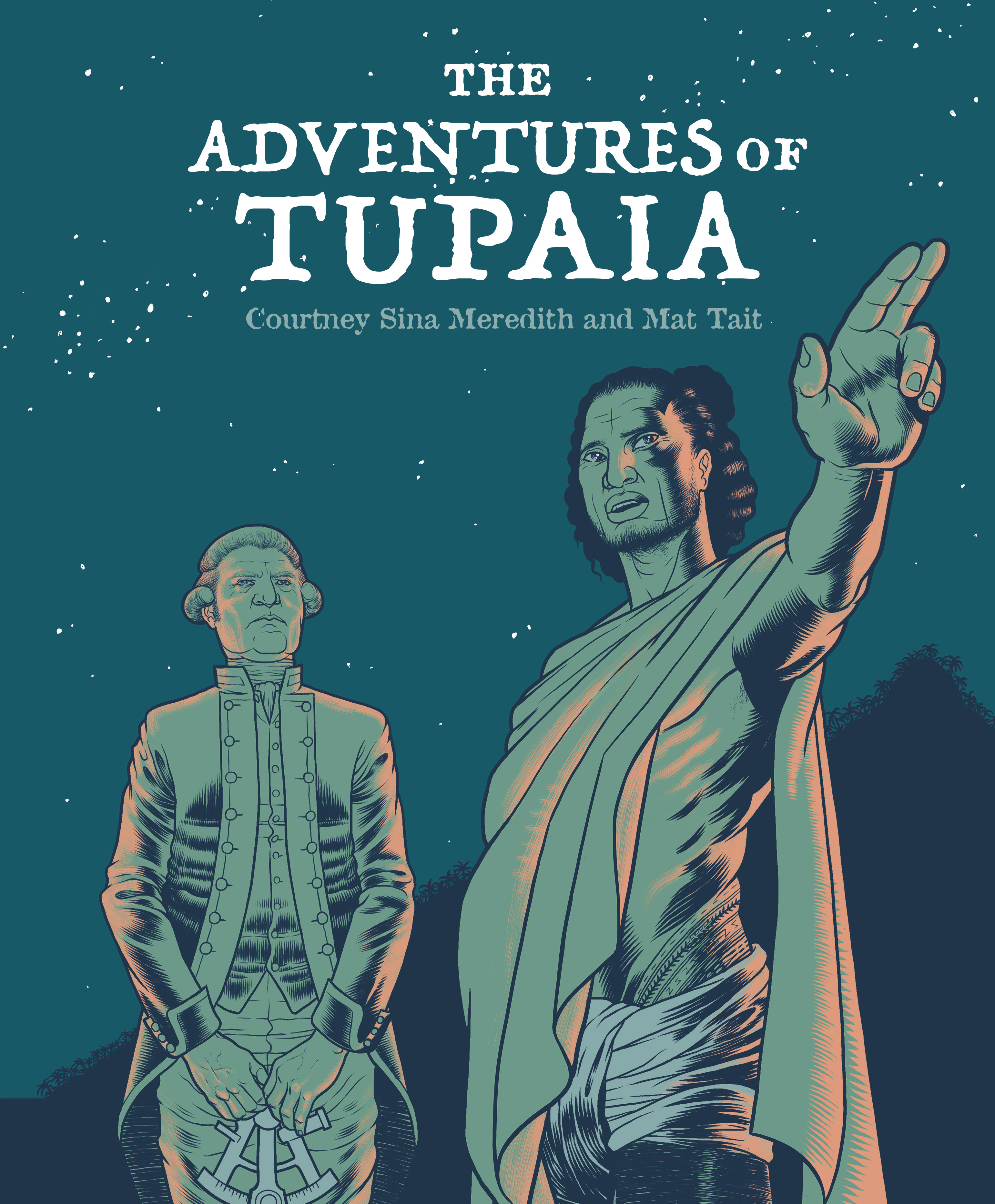
The Adventures of Tupaia
By Courtney Sina Meredith
Illustrated by Mat Tait
Allen & Unwin NZ
RRP $35
Hindsight: Pivotal Moments in New Zealand’s History by Mandy Hager (OneTree House)
Hindsight is very much an educational read – a textbook, really. It’s laid out cleanly and clearly, with plenty of photos and archival images, with accompanying graphs and data where appropriate. And it’s packed with detailed timelines – showing the way in which different moments in history led to the major points being examined. The book is both Hindsight in general looking back on these big moments, and Hindsight in how we view those events in the context of what led up to them – now that we have the benefit of being able to evaluate, rather than live those experiences.
But it’s also more than that, thanks to the fact that it has been written by Mandy Hager. She is a writer known not only for her exceptional (and award-winning) storytelling skills, but also her commitment in her work to environmentalism and equality – or, as she puts it on her website ‘the politics of love’. My first encounter with Mandy’s work was as a barely-ten-year-old reading the freshly released (at the time) Run for the Trees, so I have always thought of her as my go-to eco-conscious Kiwi YA author.
She is a writer known not only for her exceptional (and award-winning) storytelling skills, but also her commitment in her work to environmentalism and equality…
Mandy’s ethos comes through not only in the topics covered (women’s suffrage, the Springbok tour, the dawn raids, the bombing of the Rainbow Warrior) but from the very bones of the book. In the introduction, she highlights the questions we should be asking ourselves and the resources we approach when looking for information – taking into account privilege, unconscious bias, intentions and motives. It’s really exciting to me to think of our rangatahi having the chance to learn from books like this one, that bring history to life without turning it into a rollicking adventure. It feels like you’re learning, but it doesn’t feel like work.
It feels like you’re learning, but it doesn’t feel like work.
Each topic is given approximately the same amount of page space, allowing for a variety of useful angles and tangents to feature. There are glossaries, bibliographies, lists of related figures to look up, quotes from those on both sides of history. Relevant newspaper cartoons appear, as do plenty of snippets from articles and letters – there are many highlights, but one has to be a letter to the North Otago Times from one Marion Hatton regarding one Mr Fish and his getting what’s coming to him when women get the vote.
Much beloved author/illustrator Vasanti Unka has done the design work on the book, and it’s an excellent job – I’d be putting money on this one taking out the PANZ Book Design Award in the education category next year. It’s easy to follow, with plenty of break out bits and bobs to keep things interesting, and should be used as a reference for other designers of such books. It’s possible to keep things interesting and fresh while still remaining slick – and doing so in a way that’s visually appealing to young people.
This book would be well paired with relevant books in the My New Zealand Story series – namely Pauline (Vaeluaga) Smith’s Dawn Raid, Sharon Holt’s Rainbow Warrior, Janine McVeagh’s Be Counted and Bill Nagelkerke’s Sitting on the Fence (now out of print). The target age of Hindsight skews older than those novels, but they would still be good extra reads to bulk out understanding of living through these ‘pivotal moments’ as the subtitle says.
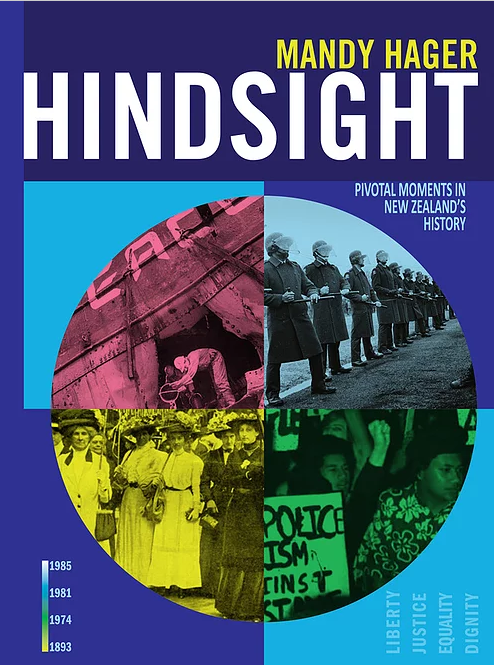
Hindsight: Pivotal Moments in New Zealand’s History
by Mandy Hager and designed by Vasanti Unka
OneTree House
RRP $40

Briar Lawry is an English teacher and writer from Tāmaki Makaurau. She worked in bookshops for years, most notably Little Unity, and judged the NZCYA Awards in 2020. She was also one of the editors of The Sapling between 2019 and 2023.



